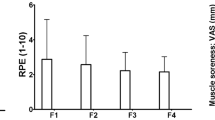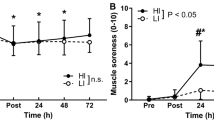Abstract
Eccentric exercise is known to cause changes to the ultrastructure of skeletal muscle and, in turn, may alter the ability of the muscle to store and utilise intracellular substrates such as intramyocellular lipid (IMCL). The purpose of this study was to test the hypothesis that exercise-induced muscle damage (EIMD) results in IMCL accumulation. Six males (31 ± 6 years; mean ± SD, and 72.3 ± 9.7 kg body mass) performed 300 unilateral, maximal, isokinetic, eccentric contractions (Ecc) (30° s−1) of the quadriceps on an isokinetic dynamometer, followed immediately by an equal amount of work by the contralateral leg but with concentric action (Con). Phosphate compounds and IMCL content of the vastus lateralis of both legs were measured using 31P and 1H magnetic resonance spectroscopy. IMCL content was higher in Ecc than Con 24 h post but the reverse was evident 48 h post-exercise (P = 0.046). A significant time × trial interaction for resting [Pi] (P = 0.045), showed increases in Ecc across time but no change in Con. A significant main effect of trial (P = 0.002) was apparent indicating the Ecc leg had marked metabolic dysfunction. The Pi/PCr ratio showed a significant effect of trial (P = 0.001) with an increase evident in Ecc leg, primarily due to increases in [Pi]. The present study highlights changes in IMCL content of skeletal muscle following EIMD.


Similar content being viewed by others
References
Argov Z, Bank WJ, Maris J, Peterson P, Chance B (1987) Bioenergetic heterogeneity of human mitochondrial myopathies: phosphorus magnetic-resonance spectroscopy study. Neurology 37(2):257–262
Baker AJ, Kostov KG, Miller RG, Weiner MW (1993) Slow force recovery after long-duration exercise—metabolic and activation factors in muscle fatigue. J Appl Physiol 74(5):2294–2300
Balnave CD, Davey DF, Allen DG (1997) Distribution of sarcomere length and intracellular calcium in mouse skeletal muscle following stretch-induced injury. J Physiol 502(3):649–659
Byrne C, Eston RG, Edwards RHT (2001) Characteristics of isometric and dynamic strength loss following eccentric exercise-induced muscle damage. Scand J Med Sci Sports 11(3):134–140
Byrne C, Twist C, Eston R (2004) Neuromuscular function after exercise-induced muscle damage—theoretical and applied implications. Sports Med 34(1):49–69
Clarkson PM, Nosaka K, Braun B (1992) Muscle function after exercise-induced muscle damage and rapid adaptation. Med Sci Sports Exerc 24(5):512–520
Costill DL, Pascoe DD, Fink WJ, Robergs RA, Barr SI, Pearson D (1990) Impaired muscle glycogen resynthesis after eccentric exercise. J Appl Physiol 69(1):46–50
Del Aguila LF, Krishnan RK, Ulbrecht JS, Farrell PA, Correll PH, Lang CH et al (2000) Muscle damage impairs insulin stimulation of IRS-1, PI 3-kinase, and Akt-kinase in human skeletal muscle. Am J Physiol Endocrinol Metab 279(1):E206–E212
Feasson L, Stockholm D, Freyssenet D, Richard I, Duguez S, Beckmann JS et al (2002) Molecular adaptations of neuromuscular disease-associated proteins in response to eccentric exercise in human skeletal muscle. J Physiol 543(1):297–306
Friden J, Sjostrom M, Ekblom B (1983) Myofibrillar damage following intense eccentric exercise in man. Int J Sports Med 4(3):170–176
Hamer PW, McGeachie JM, Davies MJ, Grounds MD (2002) Evans Blue Dye as an in vivo marker of myofibre damage: optimising parameters for detecting initial myofibre membrane permeability. J Anat 200(1):69–79
Hesselink MKC, Kuipers H, Keizer HA, Drost MR, Van der Vusse GJ (1998) Acute and sustained effects of isometric and lengthening muscle contractions on high-energy phosphates and glycogen metabolism in rat tibialis anterior muscle. J Muscle Res Cell Motil 19(4):373–380
Holloszy JO, Kohrt WM, Hansen PA (1998) The regulation of carbohydrate and fat metabolism during and after exercise. Front Biosci 3:d1011–d1027
Johnson NA, Stannard SR, Mehalski K, Trenell MI, Sachinwalla T, Thompson CH et al (2003) Intramyocellular triacylglycerol in prolonged cycling with high- and low-carbohydrate availability. J Appl Physiol 94:1365–1372
Johnson NA, Stannard SR, Rowlands DS, Chapman PG, Thompson CH, O’Connor H et al (2006) Effect of short-term starvation versus high-fat diet on intramyocellular triglyceride accumulation and insulin resistance in physically fit men. Exp Physiol 91(4):693–703
Kano Y, Sampei K, Matsudo H (2004) Time course of capillary structure changes in rat skeletal muscle following strenuous eccentric exercise. Acta Physiol Scand 180(3):291–299
Kelley DE, Goodpaster BH, Storlien L (2002) Muscle triglyceride and insulin resistance. Annu Rev Nutr 22:325–346
Kemp GJ, Meyerspeer M, Moser E (2007) Absolute quantification of phosphorus metabolite concentrations in human muscle in vivo by P-31 MRS: a quantitative review. NMR Biomed 20(6):555–565
Kiens B, Richter EA (1998) Utilization of skeletal muscle triacylglycerol during postexercise recovery in humans. Am J Physiol Endocrinol Metab 38(2):E332–E337
Lovering RM, De Deyne PG (2004) Contractile function, sarcolemma integrity, and the loss of dystrophin after skeletal muscle eccentric contraction-induced injury. Am J Physiol Cell Physiol 286(2):C230–C238
McCully KK, Argov Z, Boden BP, Brown RL, Bank WJ, Chance B (1988) Detection of muscle injury in humans with 31-P magnetic-resonance spectroscopy. Muscle Nerve 11(3):212–216
McCully K, Shellock FG, Bank WJ, Posner JD (1992) The use of nuclear magnetic resonance to evaluate muscle injury. Med Sci Sports Exerc 24(5):537–542
Nardone A, Romano C, Schieppati M (1989) Selective recruitment of high-threshold human motor units during voluntary isotonic lengthening of active muscles. J Physiol 409:451–471
Newham DJ, Mills KR, Quigley BM, Edwards RHT (1983) Pain and fatigue after concentric and eccentric muscle contractions. Clin Sci 64(1):55–62
Nikolaidis MG, Paschalis V, Giakas G, Fatouros IG, Sakellariou GK, Theodorou AA et al (2008) Favorable and prolonged changes in blood lipid profile after muscle-damaging exercise. Med Sci Sports Exerc 40(8):1483–1489
O’Reilly KP, Warhol MJ, Fielding RA, Frontera WR, Meredith CN, Evans WJ (1987) Eccentric exercise-induced muscle damage impairs muscle glycogen repletion. J Appl Physiol 63(1):252–256
Rico-Sanz J, Hajnal JV, Thomas EL, Mierisova S, Ala-Korpela M, Bell JD (1998) Intracellular and extracellular skeletal muscle triglyceride metabolism during alternating intensity exercise in humans. J Physiol 510(2):615–622
Ross R, Rissanen J, Pedwell H, Clifford J, Shragge P (1996) Influence of diet and exercise on skeletal muscle and visceral adipose tissue in men. J Appl Physiol 81(6):2445–2455
Smith LL, Anwar A, Fragen M, Rananto C, Johnson R, Holbert D (2000) Cytokines and cell adhesion molecules associated with high-intensity eccentric exercise. Eur J Appl Physiol 82(1):61–67
Stannard SR, Johnson NA (2004) Insulin resistance and elevated triglycericle in muscle: more important for survival than ‘thrifty’ genes? J Physiol 554(3):595–607
Stannard SR, Johnson NA (2006) Energy well spent fighting the diabetes epidemic. Diabetes Metab Res Rev 22(1):11–19
Su Q-S, Zhang J-G, Dong R, Hua B, Sun J-Z (2009) Comparison of changes in markers of muscle damage induced by eccentric exercise and ischemia/reperfusion. Scand J Med Sci Sports. doi:10.1111/j.1600-0838.2009.01015.x
Taylor DJ, Styles P, Matthews PM, Arnold DA, Gadian DG, Bore P et al (1986) Energetics of human-muscle—exercise-induced ATP depletion. Magn Reson Med 3(1):44–54
Warren GL, Lowe DA, Hayes DA, Karwoski CJ, Prior BM, Armstrong RB (1993) Excitation failure in eccentric contraction-induced injury of mouse soleus muscle. J Physiol 468:487–499
Widrick JJ (2002) Effect of P-i on unloaded shortening velocity of slow and fast mammalian muscle fibers. Am J Physiol Cell Physiol 282(4):C647–C653
Widrick JJ, Costill DL, McConell GK, Anderson DE, Pearson DR, Zachwieja JJ (1992) Time course of glycogen accumulation after eccentric exercise. J Appl Physiol 72(5):1999–2004
Conflicts of interest
The authors declare that they have no conflict of interests.
Author information
Authors and Affiliations
Corresponding author
Additional information
Communicated by Jean-René Lacour.
Rights and permissions
About this article
Cite this article
Hughes, J.D., Johnson, N.A., Brown, S.J. et al. Effects of eccentric exercise-induced muscle damage on intramyocellular lipid concentration and high energy phosphates. Eur J Appl Physiol 110, 1135–1141 (2010). https://doi.org/10.1007/s00421-010-1605-5
Accepted:
Published:
Issue Date:
DOI: https://doi.org/10.1007/s00421-010-1605-5




